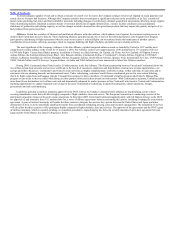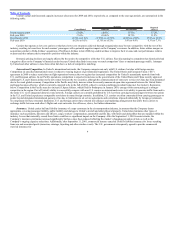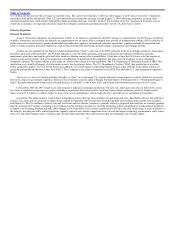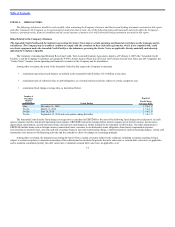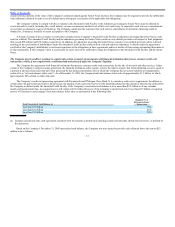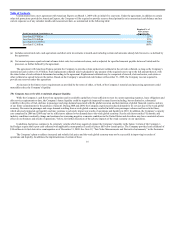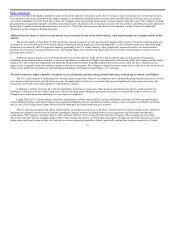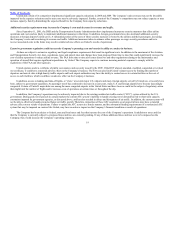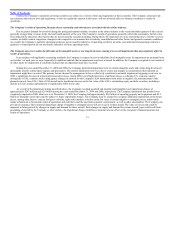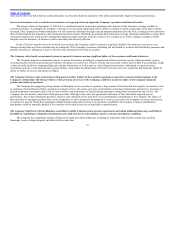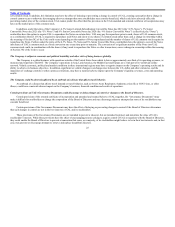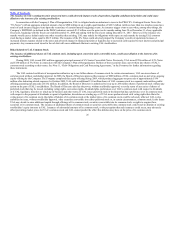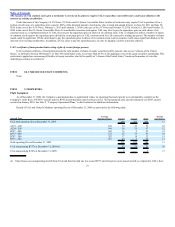United Airlines 2009 Annual Report Download - page 21
Download and view the complete annual report
Please find page 21 of the 2009 United Airlines annual report below. You can navigate through the pages in the report by either clicking on the pages listed below, or by using the keyword search tool below to find specific information within the annual report.
Table of Contents
plans requires the use of cash for such items as severance payments, lease termination fees and facility closure costs, among others. These cash requirements will
reduce the Company’s available cash for its ongoing operations.
As described above, the Company is required to comply with certain financial covenants under its Amended Credit Facility, the indentures governing the
Senior Notes and certain of its credit card processing agreements. The factors noted above, among other things, may impair the Company’s ability to comply
with these covenants or could allow certain of our credit card processors to increase the required reserves on our advance ticket sales, which could have an
adverse impact on the Company’s financial position and liquidity, depending on its ability to obtain a waiver of, or otherwise mitigate, the impact of the default.
If a default occurs under our Amended Credit Facility and the indentures governing the Senior Notes, the cost to cure any such default may adversely impact our
financial position and liquidity.
In addition, the Company’s indebtedness at December 31, 2009 was secured by collateral with a net carrying value of $8.0 billion. As a result, we may
have limited remaining assets available as collateral for loans or other indebtedness, which may make it difficult to raise additional capital to meet our liquidity
needs. Our level of indebtedness, non-investment grade credit rating and the current market conditions may also make it difficult for us to raise capital to meet
liquidity needs and may increase our cost of borrowing. A higher cost of capital could negatively impact our results of operations, financial position and liquidity.
See Item 7, Management’s Discussion and Analysis of Financial Condition and Results of Operations, for further information regarding the Company’s
liquidity.
Economic and industry conditions constantly change and continued or worsening negative economic conditions in the United States and elsewhere may have
a material adverse effect on our business and results of operations.
Our business and results of operations are significantly impacted by general economic and industry conditions. Industry-wide passenger air travel varies
from year to year. Robust demand for our air transportation services depends largely on favorable general economic conditions, including the strength of the
global and local economies, low unemployment levels, strong consumer confidence levels and the availability of consumer and business credit. For leisure
travelers, air transportation is often a discretionary purchase that those consumers can eliminate from their spending in difficult economic times. In addition,
during periods of poor economic conditions, businesses usually reduce the volume of their business travel, either due to cost-savings initiatives or as a result of
decreased business activity requiring travel. The overall demand for air transportation in the United States has decreased due to adverse changes and continued
deterioration of the U.S. and global economies, which has negatively impacted our results of operations for the years ended December 31, 2009 and 2008, and
may continue to have a significant negative impact on our future results of operations for an extended period of time. While some economic indicators like the
GDP are beginning to exhibit growth, other economic indicators that affect air travel such as unemployment have not yet begun to recover and may not do so for
an extended period of time. In addition, decreases in cargo revenues due to lower demand have a disproportionate impact on our operating results as our cargo
revenues generally have higher margins as compared to our passenger revenues. Continuation or worsening of the current global recession may lead the
Company and other carriers to further reduce domestic or international capacity and may have a material adverse effect on the Company’s revenues, results of
operations and liquidity.
Continued periods of historically high fuel costs or significant disruptions in the supply of aircraft fuel could have a material adverse impact on the
Company’s operating results.
The Company’s operating results have been, and could continue to be, significantly impacted by changes in the supply or price of aircraft fuel, both of
which are impossible to predict. The record-high fuel prices each year from 2005 through 2007 increased further in 2008 to new record highs with the crude oil
spot price reaching approximately $145 per barrel in July 2008. At times, United has not been able to increase its fares when fuel
17


